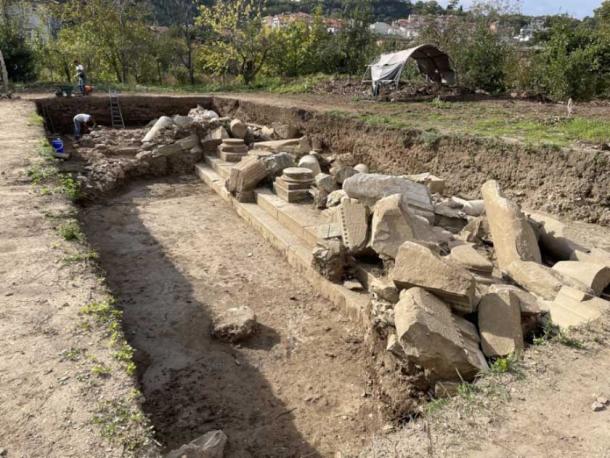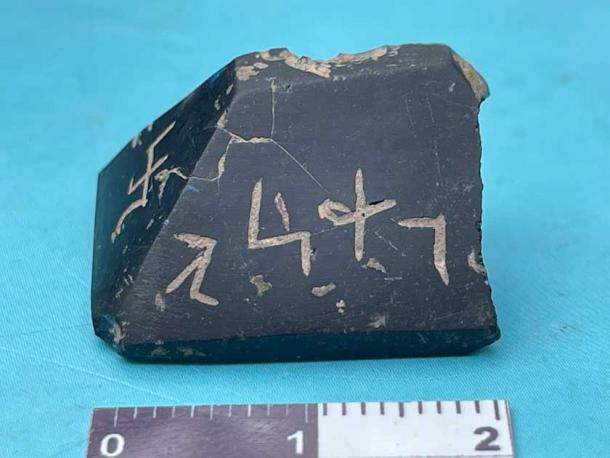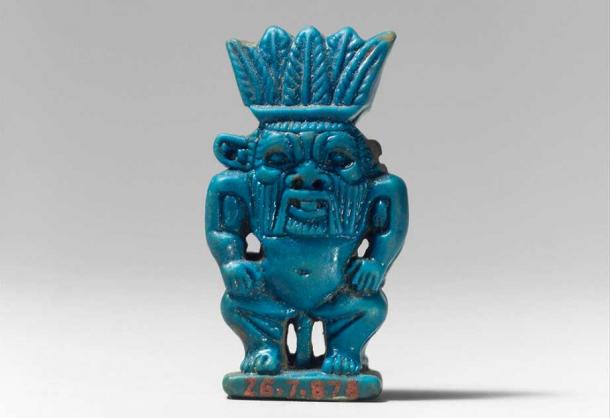
Mystical Egyptian Amulet Depicting Protective Deity Found in Turkey
Archaeologists excavating a Roman-era ruin in the ancient city of Amastris in Turkey have recently made the curious discovery of a talismanic amulet seal. The pyramid-shaped Egyptian amulet has hieroglyphic characters and ancient Egyptian symbols etched on it, which have provided an element of mystery and suspense surrounding the find.

The Egyptian amulet was found during excavations of Roman ruins in Amastris, Turkey. (AA Photo)
Ancient Roman Ruins Revealed During School Construction
Amastris is located in northern Turkey’s Amasra district in Bartin province. The site in the Kum neighborhood of Amasra was earmarked for a school building in 2014. But when construction work started there, some remains thought to be from the Roman period were discovered. Construction was halted and the site was taken under protection by the authorities, according to the Daily Sabah.
- Saint Nicholas Discovery! Has the Tomb of the Real Santa Been Found in Turkey?
- Ancient Tomb of Bird Oracle Priest Found in Turkey’s Pergamon
Excavations to salvage the ruins were started by the Amasra Museum Directorate under the guidance of Bartin University in 2017, leading to the discovery of some columns and other architectural remains, according to DHA English. In June 2022, excavations began again and have continued to yield abundant historical remains.
Five, 6-meter long (19.68 ft) columns placed on marble pedestals carved with eagle figures have been found on a 2-decare (2,000 sq m) plot of land. Ninety-six coins and 122 other artifacts of various sizes from the Roman period have also been unearthed.

The unique Egyptian amulet is the only example of its kind to have been uncovered within a Roman structure in Turkey. (AA Photo)
Finding of Egyptian Amulet Excites Archaeologists
Recently, however, archaeologists have made a unique find. Amongst the ruins they unearthed a talismanic amulet inscribed with various characters and figures believed to be Egyptian. “It is possible to say that this is the only example found in a Roman structure in Anatolia,” explained Dr. Fatma Bağdatlı Çam, Head of Archaeology at Bartın University, when discussing the Egyptian amulet with Hurriyet. “It was a find that excited us.”
The Egyptian amulet is in the shape of a pyramidal stamp seal 2 centimeters (0.78 inches) in height. A right hand holding a sword, two wings and various demotic Egyptian letters are inscribed on the amulet that has a square base that tapers to a pyramid shape. It is made of obsidian stone.
“We see that there is a figure depicting the god Bes, whom we know from the Egyptian religion, depicted with incised lines at the base of the work,” explained Çam in the Daily Sabah. “On the upper part of the work, we see that there are letter characters and talismanic words from the ancient Egyptian religion called demotic.”
“The letter characters on the work probably represent this meaning of protection,” continued Çam. “As a kind of talismanic object, we can define it as an object that a person wears to be protected from evil and diseases or in whatever sense he wants to be protected. We can say that it is the only example of its kind found from the Roman layer in Anatolia during excavations.”

In ancient Egypt, Bes was a god used to avert evil. The Bes amulet was a popular amulet. (Public domain)
What Makes the Egyptian Amulet Special?
Bes was a protective deity of ancient Egypt, worshipped as the protector of households, mothers, children and childbirth. With time, the protective role of Bes became more generalized and he was deemed as a guardian of all that is good and destroyer of all evil.
According to Çam, the amulet seal is one of the most remarkable finds from the second-century Roman structure built of marble. This is because such stamp seals are more commonly associated with the Assyrian Achaemenid periods and its discovery in the Roman remains is quite unexpected. Besides, the seal bears distinctly Egyptian markings.
- Roman Gladiator Tombs Found By Team of 54 “Dig Hunters” in Turkey
- Massive Mosaic Depicting the 12 Labors of Heracles Unearthed in Turkey
As of now, any explanation of how the seal found its way to the Roman-era building in Amastris can only be speculative. However, the archaeological team means to study the Egyptian amulet, its provenance, purpose and journey more closely to find a clearer answer. “We will investigate what this seal means and whether the person wearing it is a priest, a religious official, or whether someone carries it for health and safety purposes. Perhaps we will find out whether a soldier in the legion brought it here (after) his mission in the east.”
Top image: Ancient Egyptian amulet seal discovered in Turkey. Source: AA Photo
By Sahir Pandey
References
Anadolu Agency. 9 November 2022. “Enchanted ancient Egyptian amulet seal found in Türkiye's Amasra” in Daily Sabah. Available at: https://www.dailysabah.com/life/history/enchanted-ancient-egyptian-amulet-seal-found-in-turkiyes-amasra
Alisan KOYUNCU. 26 October 2022. “‘Talismanic amulet’ found in ruins of the Roman period building” in DHA. Available at: https://www.dha.com.tr/english/talismanic-amulet-found-in-ruins-of-the-roman-period-building-2159081
Hurriyet. 2022. “Amasra'da 'tılsımlı amulet' bulundu! 'Heyecanlandıran bir tespit'” in Hurriyet. Available at: https://www.hurriyet.com.tr/gundem/amasrada-tilsimli-amulet-bulundu-heyecanlandiran-bir-tespit-42167716
















Comments
You’ve never read my theory on Atlantis? Sorry to all for being redundant, but here goes again.
Plato’s description of Atlantis is dead on, but somebody threw a monkey wrench into it by removing a zero from the timeline. Instead of 11,500 years ago, it must have originally been recorded as 111,500 years ago, which then places it at the very start of the Ice Age, which we know came on very suddenly. Before the Ice Age, there were NO ICE CAPS, and thus seas would have been as much as 500 feet higher than today. We also know that the Sahara was lush prior to the Ice Age. Now look at the Richat Structure in Mauritania. With seas 500 feet higher, that valley would have been as estuary, exactly as Plato described. You can still see the concentric rings. The red, black and white stone Plato said they used is native to that area. Of course you got there by boat from the Med as he described, and the Atlas Mtns are right where he said they were.
Not the first time dates have been 'messed with'. Isaac Newton caught the Church doing it, he wrote about it, and that got Isaac in some trouble.
Nobody gets paid to tell the truth.
I love when clear signs of trade or obvious examples of the ancient people integrating with different cultures.
Atlantis was not a real place. Plato wrote of its location- "For the ocean there was at that time navigable; for in front of the mouth which you Greeks call, as you say, 'the pillars of Heracles,' (i.e., Hercules) there lay an island which was larger than Libya and Asia together." Crazy how we haven't found any evidence of a land mass larger than Libya and Asia mashed together around the Straits of Gibraltar. Crazy. I love of people idolize a place with only one written record of its existence. With absolutely no other evidence. Then, those people discount anything found and call archeologists dubious or frauds based on a story. Certainly people who have dedicated their adult lives to the study and methods of archeology and human history couldn't know more than a story that has literally no basis in fact.
Because they’ve discovered so much more, in terms of artifacts, over the decades, from Egyptian sites than from the sites in Turkey, which hasn’t drawn the same level of interest over that time, they are only now starting to find and question these types of similarities. Then in light of the dubious knee-jerk tendency to credit Rome (incorrectly) for having produced whatever they stumble, the question becomes what ruins and artifacts predate even ancient Egypt, e.g., go all the way back to the Atlanteans? Maybe the Egyptian culture is acutally similar to the Inca’s in a way, in terms of it being largely influenced by all that (what we call artifacts) was already there, left behind (buried in the ruins) by the prior civilization that had, as told by Plato, been wiped out? And if so, it’s possilbe, maybe likely, that the Atlantean culture spanned continents.
Nobody gets paid to tell the truth.